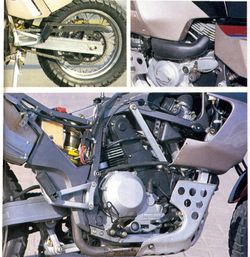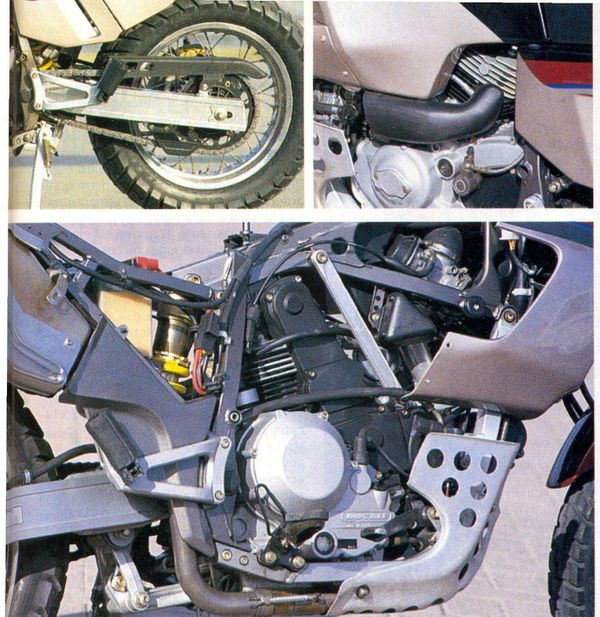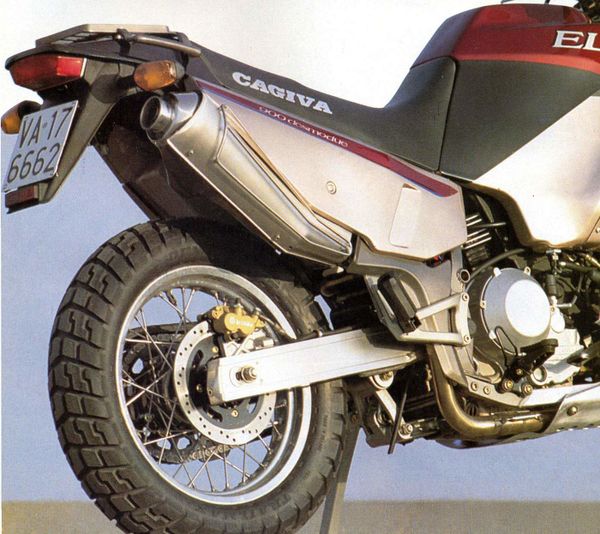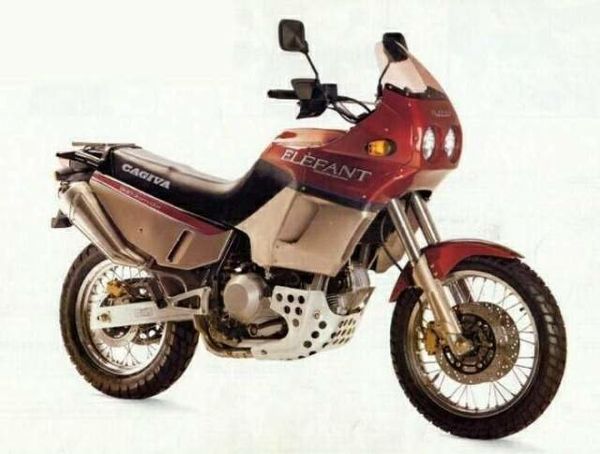Cagiva Elefant 900AC
 |
|
| Cagiva Elefant 900AC | |
| Manufacturer | |
|---|---|
| Production | 1994 |
| Engine | Four stroke, 90° L twin cylinder, SOHC, desmodromic 2 valve per cylinder |
| Compression ratio | 9.2:1 |
| Top Speed | 183.4 km/h / 114. mph |
| Ignition | Marelli electronic inductive discharge |
| Transmission | 6 Speed |
| Frame | Double steel tubular cradle |
| Suspension | Front: 45mm Showa upside down telescopic forks Rear: Rising rate box, monoshock adjustable for preload |
| Brakes | Front: 2x 282mm discs 4 piston calipers Rear: Single 240mm disc 4 piston caliper |
| Front Tire | 100/90-19 |
| Rear Tire | 140/80-17 |
| Wheelbase | 1570 mm / 61.8 in |
| Seat Height | 857 mm / 33.7 in |
| Weight | 204 kg / 449.7 lbs (dry), |
| Fuel Capacity | 22 Liters / 5.8 US gal |
| Manuals | Service Manual |
It could reach a top speed of 183.4 km/h / 114. mph.
Engine[edit | edit source]
The engine was a Air cooled cooled Four stroke, 90° L twin cylinder, SOHC, desmodromic 2 valve per cylinder. The engine featured a 9.2:1 compression ratio.
Drive[edit | edit source]
Power was moderated via the Dry Multi-disc.
Chassis[edit | edit source]
It came with a 100/90-19 front tire and a 140/80-17 rear tire. Stopping was achieved via 2x 282mm discs 4 piston calipers in the front and a Single 240mm disc 4 piston caliper in the rear. The front suspension was a 45mm Showa upside down telescopic forks while the rear was equipped with a Rising rate box, monoshock adjustable for preload. The Elefant 900AC was fitted with a 22 Liters / 5.8 US gal fuel tank. The bike weighed just 204 kg / 449.7 lbs. The wheelbase was 1570 mm / 61.8 in long.
Photos[edit | edit source]
Overview[edit | edit source]
Cagiva Elefant 900AC
The popularity of the Paris-Dakar
Rally in Europe has spawned a whole generation of enormous on/off-road
superbikes, and none of them is more impressive than the Cagiva 900 Elefant.
The Paris-Dakar covered thousands
of miles of desert in northern Africa, and the major motorcycle
manufacturers spent many years, and enormous quantities of money, building
bikes that would win it. Success in the Paris-Dakar translated directly to
sales in Europe.
But the demands of the Saharan marathon meant that these trailbikes had to be very big and very fast, not something normally associated with off-road bikes. They also had to be immensely rugged and capable of carrying a lot of fuel and water with them - the two-wheeled equivalent of a Landcruiser. The Cagiva 900 Elefant is a production version of the bike which triumphed in the Paris-Dakar a few years back, and is one of the biggest and best
Paris-Dakar replicas available. It's also one of the most interesting in that it uses a 900cc air and oil-cooled overhead cam 90-degree V-twin motor with desmodromic valve gear (as used on countless Ducati road and race bikes). Electronic fuel-injection helps the Elefant to produce a healthy 70bhp at 8500rpm, although brute power is less important with this kind of off-road machine than a usable spread of torque. A high level of suspension equipment is de rigeur for desert-racers, and here the Cagiva gets full marks for Marzocchi forks at the front and an Öhlins multi-adjustable monoshock at the back. Rugged long-travel suspension is a must for this type of machine, and the Elefant has it in abundance.
Hefty twin front disc brakes give the Elefant plenty of stopping power, with twin-pot Nissin calipers providing bite. A large-capacity fuel tank (although not as large as the pukka desert race bike's) and twin-headlamp fairing are also part of the essential P-D package, as is a vertiginous seat height of over 35ins. As a road bike the Elefant is surprisingly capable. Although lacking the kind of power to compete directly with road-going sports 900s, the Elefant has a wide spread of power and torque which makes it very usable on twisting back roads. And with a top speed of 120mph the Elefant offers plenty of thrills along the way.
But it is off-road where the Cagiva really excels. That lazy, low-rewing motor and low gearing make the Elefant a superb dirt bike that is equally at home idling along narrow gravel tracks or blasting at speed across open desert. The flexibility of the V-twin engine means that gear-changes are kept to a minimum, allowing the rider to concentrate on picking the right line across whatever terrain he happens to be traversing.
The long-travel suspension soaks up all but the biggest bumps, giving a soft manageable ride under almost all road and off-road conditions. That suspension travel also makes the Elefant a comfortable long-distance road mount, too. Although bikes like the Elefant can't offer the kind of searing performance a high-performance road-bike can, their go-anywhere, do-anything capabilities give them an appeal all their own. The Cagiva 900 is undoubtedly the pinnacle of on/off-road engineering. Source of overview: Super Bikes by Mac McDiarmid
| Make Model | Cagiva Elefant 900AC CAT |
|---|---|
| Year | 1994 |
| Engine Type | Four stroke, 90° L twin cylinder, SOHC, desmodromic 2 valve per cylinder |
| Displacement | 904 cc / 55.1 cu-in |
| Bore X Stroke | 92 x 68 mm |
| Cooling System | Air cooled |
| Compression | 9.2:1 |
| Induction | Mikuni BDST 38 carburetors |
| Ignition | Marelli electronic inductive discharge |
| Starting | Electric |
| Max Power | 95 hp / 70 kW @ 8500 rpm |
| Max Torque | 78 Nm / 57.5 lb-ft @ 5250 rpm |
| Clutch | Dry Multi-disc |
| Transmission | 6 Speed |
| Final Drive | Chain |
| Frame | Double steel tubular cradle |
| Front Suspension | 45mm Showa upside down telescopic forks |
| Rear Suspension | Rising rate box, monoshock adjustable for preload |
| Front Brakes | 2x 282mm discs 4 piston calipers |
| Rear Brakes | Single 240mm disc 4 piston caliper |
| Front Tire | 100/90-19 |
| Rear Tire | 140/80-17 |
| Dimensions | Length 2295 mm / 90.3 in Width 860 mm / 33.8 in Height 970 mm / 38.1 in |
| Wheelbase | 1570 mm / 61.8 in |
| Seat Height | 857 mm / 33.7 in |
| Ground Clearance | 260 mm / 10.2 in |
| Dry Weight | 204 kg / 449.7 lbs |
| Fuel Capacity | 22 Liters / 5.8 US gal |
| Consumption Average | 38.0 mpg |
| Standing ¼ Mile | 13.2 sec / 95.5 mph |
| Top Speed | 183.4 km/h / 114. mph |
| Road Test | Motosprint 1993 |


